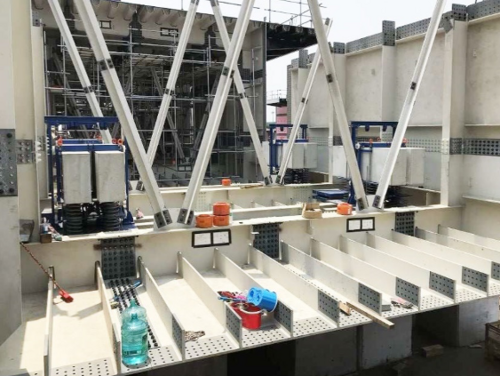168 t mass damp India's longest sea bridge
Mumbai. Spans of up to 180m make India's longest sea bridge from Mumbai to the port a challenge because the bridge is made of steel. This would mean vertical vibrations of up to 300mm in case of crosswinds. MAURER damped critical areas with special absorbers: the dampers with a mass of up to 4,800kg each reduce vibrations by a factor of 15. In addition, vertical guides and hydraulic dampers keep the large vibrating damper masses under control. The system is designed to last 50 years.
The Mumbai Trans Harbour Link (MTHL, also: Sewri Nhava Sheva Harbour Link) will be 21.8km long and will connect Mumbai with Navi Mumbai. India's longest sea bridge is expected to accommodate 70,000 vehicles per day across 6 lanes from the end of 2023, reducing travel time from 2 hours to 20 minutes. This will reduce congestion and enable further development of the port region.
The overall project consists of 4 construction packages. For this, MAURER supplied a total of 1,100 elastomeric bearings, 461 spherical bearings, 160 pot bearings, 880m of roadway transitions and 40 vibration dampers. "The vibration dampers were the real challenge," reports project manager Dipl.-Ing. Peter Huber from MAURER. "We therefore developed and calculated them for the situation on site in coordination with JFE Engineering Corporation, the contracting engineering firm, and will fine-tune them after installation."
Steel plus wind plus long spans On the relevant, 1.75km-long steel bridge section, several vibration-amplifying factors come together:
- Enormous spans of 100-180m.
- A steel box girder with an orthotropic deck, i.e. a very lightweight construction that derives its high load-bearing capacity from numerous bracings. Concrete would not have been possible due to its high dead weight. Steel is lighter, but also softer, more elastic and therefore vibrates more strongly.
- Crosswinds lead to so-called vortex shedding from a wind speed of about 20m/sec in the lee of the bridge. If these hit the natural resonance of the bridge, they can lead to vibrations with amplitudes of up to ±300mm in the center of the bridge spans.
- Because the spans are so large, the natural frequency is very low, below 0.8Hz.
In principle, the orthotropic steel decks would tolerate this vibration for a relatively long time. But for reasons of ride comfort and service life, significant damping was required.
Dampers reduce vibration by a factor of 15 MAURER developed spring-mass dampers (MTMD-V) for this purpose, each with an absorber mass of up to 4,800kg. The mass consists mainly of concrete. On top there is a variable number of steel plates, with which the damper mass can be subsequently adjusted exactly to the actual natural frequency of the bridge.
The absorber mass rests on up to 20 steel spiral springs. On these, it oscillates up and down by up to ±400mm according to the precalculated amplitude. This reduces bridge deck vibration by a factor of 15 to a maximum of ±20mm, which effectively reduces bridge deck fatigue.
Vertical guidance and additional hydraulic dampers This relatively high vibration amplitude of the mass in the damper places enormous stress on the springs, and the demands on the strength of the spring steel were correspondingly high. In addition, the mass must always remain under control - in every direction. To ensure that the mass oscillates exactly vertically and thus functions efficiently, high-quality vertical guides with ball bearings were installed. To brake the mass, piston hydraulic dampers were fitted. They prevent the spring system from going on block under the mass and damaging the springs.
The hydraulic dampers were designed to be virtually frictionless and wear-free in the piston guides and seals: with a non-contact inner seal. The entire damper system was tested over 400km of accumulated vibration travel. This produced temperatures of up to 160°C, which the system withstood without wear or leakage. This means that even if the wind blows for a long time, there is no fatigue in the springs or wear in the hydraulic dampers. The bridge vibration is thus effectively and permanently braked for 50 years and longer.
The spring-mass plus piston hydraulic damper design requires relatively little space. This has made the overall design lighter and handling easier for installation. The vibration dampers were produced entirely in Munich and then lifted into the bridge deck and fastened on site. "This was a specification from JFE to meet high quality requirements and minimize installation risks," Huber reports.
MAURER technology and know-how were already known to the planning office JFE from the Skypark with the Marina Bay Sands Hotel in Singapore.

